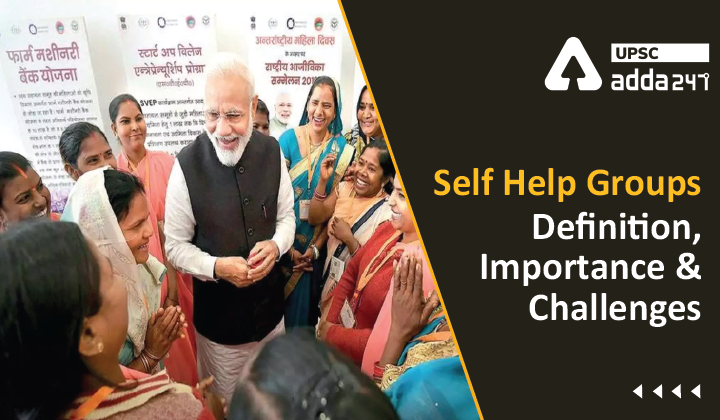Table of Contents
SHG UPSC
What is SHG?
- Self Help Groups are informal associations of people who come together to find ways to improve their living conditions.
- The SHG members generally have similar socio-economic background.
- They help to build social capital among the poor, especially women.
- Such groups work as a collective guarantee system for members who propose to borrow from organised sources.
- Consequently, Self-Help Groups have emerged as the most effective mechanism for delivery of micro-finance services to the poor.
- SHG examples: SEWA in Gujarat, MYRADA in Karnataka, TANWA in Tamil Nadu, Ramkrishna mission in Jharkhand, ADITHI in Bihar.
स्वयं सहायता समूह एवं ई-शक्ति: परिभाषा, महत्व, चुनौतियां तथा संस्तुतियां
SHG functions
- to encourage and motivate its members to save,
- to persuade them to make a collective plan for generation of additional income,
- to act as a conduit for formal banking services to reach them.
SHG benefits
- Provides mutual support to the participants in saving money.
- Group formation becomes convenient tool for credit delivery in rural areas.
- Multiplier effect in improving women’s status in society as well as in the family.
- Contribute in reducing dependence on the informal money lenders.
- SHG has also enabled the participating households to spend more on education than non-
client households. - The financial inclusion through SHGs has led to reduced child mortality, improves maternal health.
SHG limitations
- Contrary to the vision, SHG members not necessarily come from poorest family.
- Whether the economic gains are adequate to bring a qualitative change in the poor is still a matter of debate.
- Many of the activities undertaken by the SHG members are based on primitive skills.
- Financial issues like
- Poor bookkeeping
- Idle funds in SHG savings bank
- Loan diversion for social and consumption needs
- Unwillingness to take up group activities
Measures to make SHG effective
- The Government should create a supportive environment for the growth and development of the SHG movement in India.
- SHG should be expanded to credit deficient areas of the like Madhya Pradesh, Bihar, UP and the north eastern states.
- Efforts should also be made to increase income generation abilities of the urban poor who have become a victim of rapid rise in urbanisation.
- Government functionaries should treat the poor and marginalized as a responsible customer and as a possible entrepreneur.
- There is a need to establish a separate SHG monitoring cell in every state.
- These cells should have direct links with district and block level monitoring system.
- Commercial Banks and NABARD in collaboration with the State Government need to continuously innovate and design new financial products for SHG groups.
About Eshakti propram
- Eshakti is a program by NABARD for digitisation of all Self Help Group (SHG) in the country. The project is being implemented in 100 districts across the country.
Eshakti objectives
The project aims at digitisation of all the SHG accounts to bring SHG members under the fold of Financial Inclusion thereby helping them access wider range of financial services together with increasing the bankers’ comfort in credit appraisal and linkage by way of:
- Integrating SHG members with the national Financial Inclusion agenda;
- Improving the quality of interface between SHG members and Banks for efficient and hassle free delivery of banking services by using the available technology;
- Facilitate convergence of delivery system with SHGs using Aadhaar linked identity.
Read about UPSC favorite topics





 TSPSC Group 1 Question Paper 2024, Downl...
TSPSC Group 1 Question Paper 2024, Downl...
 TSPSC Group 1 Answer key 2024 Out, Downl...
TSPSC Group 1 Answer key 2024 Out, Downl...
 UPSC Prelims 2024 Question Paper, Downlo...
UPSC Prelims 2024 Question Paper, Downlo...
